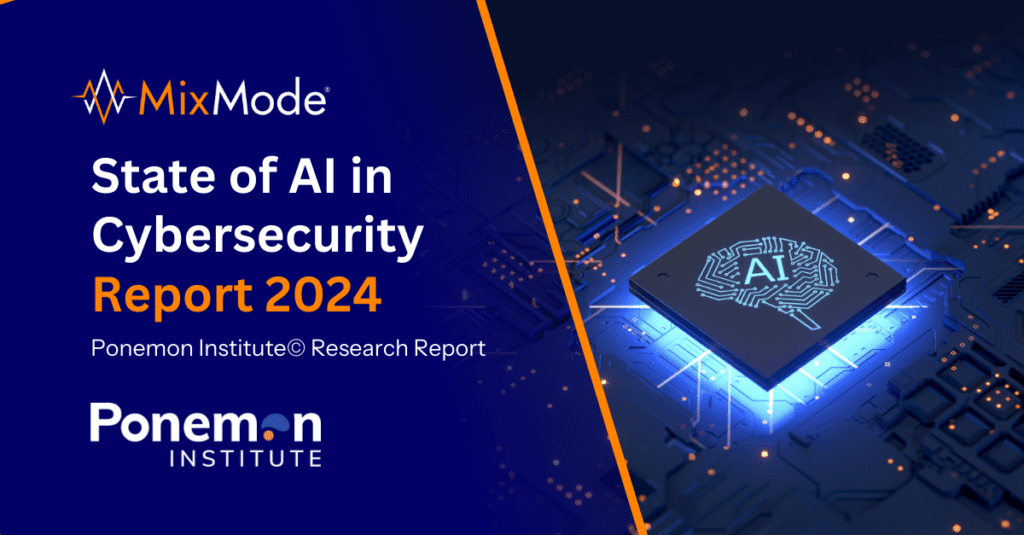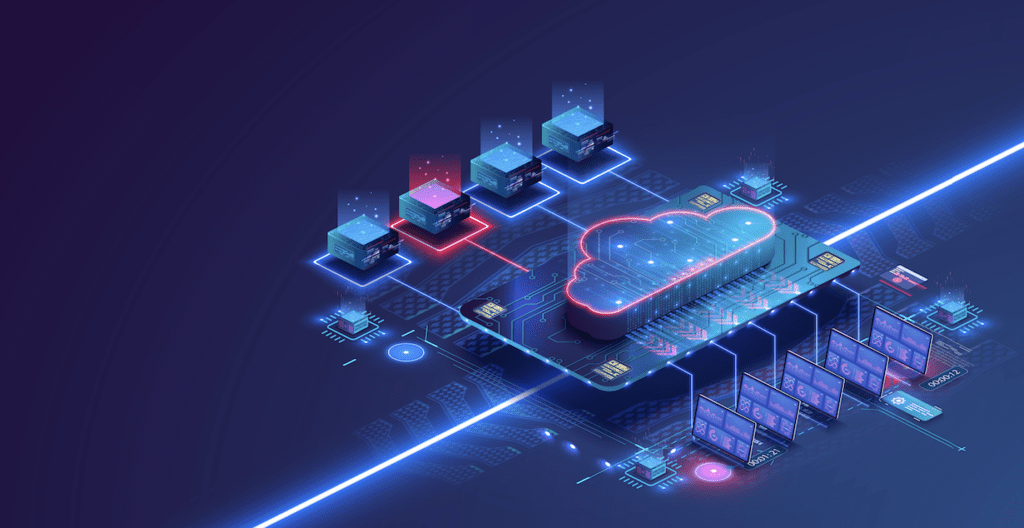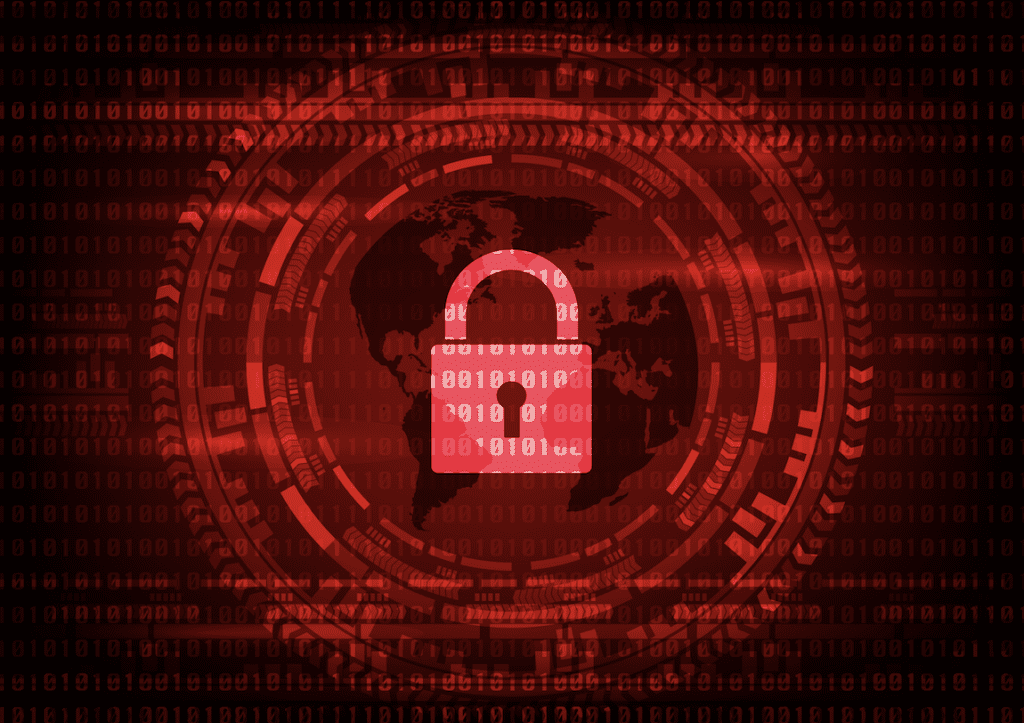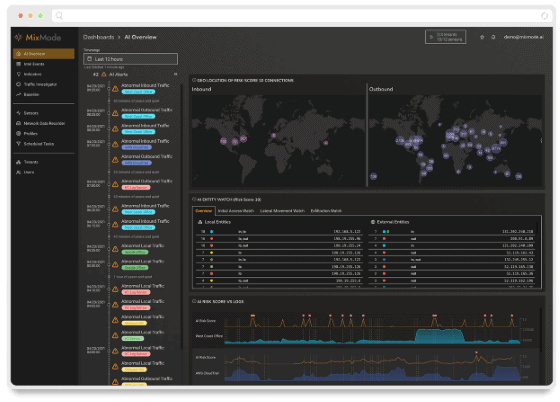The digital landscape is constantly evolving, and with it, so are the threats faced by organizations of all sizes. For enterprises, the stakes are high – securing sensitive data, protecting critical infrastructure, and maintaining operational continuity are paramount. However, achieving this in the face of an ever-changing threat landscape requires a dynamic and proactive approach to cybersecurity.

MixMode released our inaugural State of AI in Cybersecurity 2024 report, offering invaluable insights on how organizations harness AI’s power to bolster their defenses. This is the second in our blog series where we dive deeper into some of the report findings.
This week, we’re looking into how the rise of artificial intelligence (AI) has significantly altered the threat landscape, introducing challenges and opportunities for organizations seeking to safeguard their data and infrastructure.
A Shifting Landscape
The report underscores the growing severity of cyber threats, highlighting that 45% of organizations experienced one or more cyberattacks in the past year, which is alarming but not necessarily surprising. It’s particularly concerning that the most common attack vectors remain phishing/social engineering (56%), web-based attacks (51%), and credential theft (49%).
These findings highlight a few crucial aspects:
- Human vulnerability remains a critical focus: Attackers continue to exploit the human element of cybersecurity. Phishing and social engineering rely heavily on deception and psychological manipulation, targeting employees to gain initial access to systems.
- Web-based attacks persist: Web applications are constantly exposed, often presenting a large and vulnerable attack surface. This makes them a prime target for attackers seeking to exploit vulnerabilities or inject malicious code.
- Credentials are still gold: Compromise of legitimate user credentials allows attackers to move stealthily within a network, escalating privileges and exfiltrating sensitive data while remaining undetected for extended periods.

The Shifting Terrain: Understanding the New Threatscapes
Several key factors are contributing to the transformation of the cyber threat landscape:
- The rise of sophisticated attackers: Gone are the days of simplistic script kiddies. Today, attackers are often highly skilled and well-resourced, employing advanced tools and techniques to gain access to systems and data.
- The pervasiveness of cloud adoption: While cloud computing offers numerous benefits, it also introduces new vulnerabilities. Businesses need to ensure their cloud environments are properly secured and monitored.
- The explosion of connected devices: The Internet of Things (IoT) has led to an exponential increase in connected devices within organizations. These devices often have lax security measures, creating additional attack vectors for malicious actors.
- The increasing use of AI: While AI has the potential to enhance security, it’s also being weaponized by attackers. AI-powered attacks can be more targeted, efficient, and challenging to detect.
New Frontiers of Threat: Specific Challenges for Enterprises
These changes in the broader landscape translate to specific challenges for enterprises:
- Supply chain attacks: With complex and interconnected supply chains, enterprises are susceptible to attacks targeting vulnerabilities in third-party vendors.
- Ransomware attacks: These targeted attacks encrypt critical data and demand hefty ransoms, causing significant financial and operational disruption.
- Insider threats: Malicious or negligent insiders can pose a significant threat, as they often have authorized access to sensitive systems and data.
- Fileless attacks: These attacks leverage legitimate tools and bypass traditional signature-based detection methods, making them difficult to identify.

The AI Factor: A Double-Edged Sword
While AI has revolutionized various industries, it has also become an increasingly powerful tool in the arsenal of malicious actors. Adversaries now leverage AI to:
- Automate attacks and accelerate attack velocity: AI-powered tools can relentlessly scan networks, rapidly identify vulnerabilities, and launch coordinated attacks at an unprecedented scale.
- Develop sophisticated malware: AI-generated malware can morph and adapt, making it difficult for traditional signature-based detection methods to keep up.
- Enhance social engineering scams: AI-generated content such as deepfakes, personalized spear-phishing emails, and even synthetic voices can make social engineering attacks even more convincing and effective.
Confronting The Evolving Threat
The rise of AI-driven cyberattacks demands that security teams rethink their strategies and adopt the same powerful technology for defense. Here’s where AI-powered threat detection enters the picture:
- Unmasking unknown threats: Unlike signature-based defenses, advanced AI threat detection systems can identify anomalies and patterns indicative of novel attacks, including zero-day exploits and AI-generated malware.
- Analyzing behavior for early detection: AI can analyze user and device behavior in real-time, flagging suspicious deviations from established patterns. This helps identify potential insider threats, compromised accounts, or attacks leveraging fileless techniques and legitimate tools.
- Scaling threat detection: AI can process vast amounts of data from various sources, allowing for more comprehensive threat detection across large and complex IT environments.
- Automating routine tasks: AI-powered solutions automate many repetitive and time-consuming tasks involved in threat monitoring and investigation, freeing security teams to focus on higher-level analysis and strategic defense planning.
- Continuously adapting and learning: As the threat landscape evolves, AI-powered threat detection systems can continuously adapt, improving their ability to identify new threats without manual rules updates or constant human intervention.

Embracing AI as a Necessity, Not an Option
The successful use of AI-powered threat detection systems, however, requires some key considerations:
- Quality data: AI is only as effective as the data it learns from. Ensuring a continuous stream of clean and relevant data is crucial for building accurate AI models.
- Human expertise: AI should augment, not replace, the knowledge and capabilities of experienced security analysts. Human oversight and interpretation are still vital for accurate threat identification and response.
- Integration and orchestration: AI-based solutions must seamlessly integrate with existing security infrastructure and workflows to streamline security operations and enable efficient response.
Navigating the New Frontier: Why AI-powered Threat Detection is Vital
Traditional security tools are struggling to keep pace with the evolving threat landscape. Fortunately, a powerful new ally has emerged: AI-powered threat detection.
AI offers several advantages for enterprises:
- Enhanced detection of novel and evolving threats: AI can analyze vast amounts of data in real-time, identifying anomalies and patterns indicative of novel attacks, including zero-day exploits and AI-generated malware.
- Automated threat hunting and investigation: AI can continuously monitor systems and network activity, freeing security teams to focus on higher-level tasks like strategic analysis and response planning.
- Improved efficiency and reduced workload: Automating time-consuming tasks like data analysis and log monitoring allows security teams to be more efficient and focus on critical issues.
- Scalability and cost-effectiveness: AI-powered solutions can be scaled to accommodate the growing volume and complexity of data generated by modern IT environments.
The Road Ahead: Embracing AI While Prioritizing Human Expertise
While AI plays a crucial role in enterprise cybersecurity, it’s important to remember that it is a tool, not a silver bullet. Here are some additional considerations:
- Data quality: AI is only as effective as the data it learns from. Ensuring clean and relevant data is critical to building accurate AI models.
- Human expertise remains essential: AI should augment, not replace, the knowledge and capabilities of experienced security analysts. Human oversight and interpretation are still vital for accurate threat identification and response.
- Continuous improvement: The threat landscape is constantly evolving, and so should your security strategy. Regularly review and update your AI models and security measures to stay ahead of the curve.
A Proactive Approach is Key
In today’s dynamic threat landscape, a proactive and adaptive approach to cybersecurity is essential for enterprises. Embracing AI-powered threat detection while not neglecting the importance of human expertise equips organizations with the tools and strategies they need to navigate the evolving frontiers of cyber threats and protect their critical assets. Remember, staying ahead of the curve is paramount in the ongoing battle against cybercrime, and AI offers a powerful weapon in this fight.
How MixMode Can Help Security Teams with AI Adoption
In the last blog, we outlined how MixMode makes it easy for organizations to implement an AI-powered threat detection solution, so we won’t repeat that here.
By leveraging MixMode AI’s ability to detect known and novel attacks, analyze behavior patterns, and automate critical tasks, security teams can enhance their detection capabilities, improve operational efficiency, and reduce their overall risk from increasingly sophisticated cyber threats.
However, organizations must approach the adoption of AI thoughtfully, addressing integration. In the ongoing struggle against cybercrime, AI has emerged as a powerful ally, and the organizations that embrace this technology will be best positioned to navigate the ever-changing threat landscape.
Click here to download the report today to learn more, and look out for the next blog in this series.
Other MixMode Articles You Might Like
AI and Cybersecurity: A Rob Burgundy Investigation
Chat GPT and Nation-State Attackers: A New Era of AI-generated Attacks
City of Dallas Selects the MixMode Platform to Fortify Its Critical Infrastructure
The Current State of SOC Operations Shows The Escalating Need for AI in Cybersecurity

